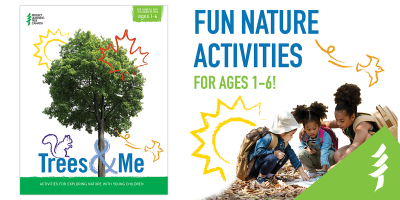Use Nature as a Learning Tool
September 04, 2024
 What do trees, bugs, and animals have in common? What do trees, bugs, and animals have in common?
STEAM!
Yes, you read that correctly. But we’re not talking about the scalding hot kind of steam. We’re talking Science, Technology, Engineering, Art, and Math. Plus, Language Arts and Social Studies!
Nature allows learners from early childhood to young adults to better understand theoretical concepts in the form of real-life scenarios. We’ve compiled a list of some fun hands-on activities and lessons to do with learners of every age.
For Early Childhood
 Activities within Trees & Me encourage children to slow down and take notice of nature and what’s around them, using their five senses. A few examples: Activities within Trees & Me encourage children to slow down and take notice of nature and what’s around them, using their five senses. A few examples:
- The Shape of Things – As part of this activity, children learn about math and shapes by spotting them in nature. What’s the shape of a maple leaf? It’s a star! What’s the shape of that tree over there? It’s a triangle. Ask children to count how many star-shaped leaves they can find or how many sticks they need to create a square.
- Sounds Around – One of the experiences of this activity is creating a forest concert. Encourage children to close their eyes and use their listening ears. From birds chirping and squirrels chattering to the wind rustling leaves and cars driving down the road, you might hear a variety of sounds. Children get to create their own forest music using their bodies and voices to mimic the sounds they hear in nature.
- Tree Textures – What makes the perfect home for a bird? In this activity, children get to engineer their very own bird nest using different materials.
For Elementary & Middle School
 Check out a few of the many activities within our Explore Your Environment: K-8 Activity Guide that help students experience nature while incorporating various subjects like science, language arts, and more: Check out a few of the many activities within our Explore Your Environment: K-8 Activity Guide that help students experience nature while incorporating various subjects like science, language arts, and more:
- Poet-Tree – After observing nearby trees, students create and share poetry to express their thoughts, feelings, and beliefs about trees and forests.
- Nature’s Skyscrapers – In this math-based activity, students measure a tree’s height, girth, and crown spread, and compare their findings to the largest known living tree in the world.
- Living with Fire – Students learn about the three elements a fire needs to burn and find out how an understanding of this “fire triangle” can be used to both prevent and manage wildland fires. They could also focus on the impact of climate change on the frequency of wildland fires. You can also find this activity in PLT Canada’s Explore Your Environment: K-8 Activity Guide and Nature of Fire digital activity collection.
 For Secondary and Post-Secondary For Secondary and Post-Secondary
- Who Works In this Forest? – Students are introduced to different forest sector careers and research to learn what it takes to perform these jobs. Explore PLT Canada’s Green Jobs: Exploring Forest Careers guide to learn more.
- Monitoring Forest Health – Students conduct a forest health checkup of a local forest area to learn about the ecological services forests provide. While seven forest health indicators are provided, you may focus on just one to start. Explore PLT Canada’s Green Jobs: Exploring Forest Careers guide to learn more.
- Climate Change & Forests – In this online-based unit, students learn about the role forests play in climate change mitigation and adaptation and brainstorm ways to reduce their carbon footprint.
Additional Learning Resources

Go on a Forest Quest! Take your learners on a journey through the forest with PLT Canada’s online learning experience, Forest Quest. Students will learn about sustainable forest management, biodiversity, Indigenous rights and relationships, and ways to fight climate change. This interactive online resource helps students understand the many ways forests touch our lives.
| |


 What do trees, bugs, and animals have in common?
What do trees, bugs, and animals have in common? Activities within
Activities within  Check out a few of the many activities within
Check out a few of the many activities within  For Secondary and Post-Secondary
For Secondary and Post-Secondary

